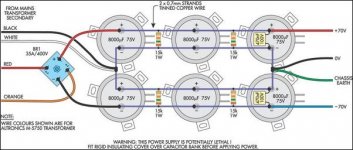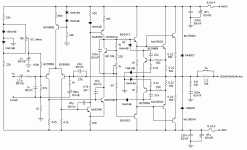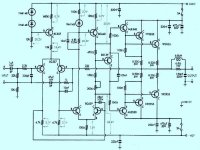I am a madman of the audio,
Can somebody help me or to say me if this design has good guys proven to be?
Has somebody constructed it?
I need slight knowledge to construct also the power supply, he has a consumption of 5A
Can somebody help me?
(copyrighted attachment deleted by moderators)
Can somebody help me or to say me if this design has good guys proven to be?
Has somebody constructed it?
I need slight knowledge to construct also the power supply, he has a consumption of 5A
Can somebody help me?
(copyrighted attachment deleted by moderators)
Studio 350 - High Power Amplifier Kit
Ref: Silicon Chip Jan/Feb 2004.
This fantastic new amplifier kit will deliver 200WRMS into a 8Ω load, or 350WRMS into a 4Ω load. It is super quiet, with a signal to noise ratio of -125dB(A) at full 8Ω power. Harmonic distortion is a fantastic 0.002%, and frequency response is almost flat between 15Hz and 60kHz. Kit supplied with PCB and all electronic components.
SC = Silicon Chip
If you can get the PCB it would be easy to build.
Notice Q7, Q8 and Q9 is on heatsink.
If you can not find BF469/470 you can replace with MJE340/350.
I think is a good amplifier, and should be safe to build.
This Kit is being sold at several websites.
Silicon Chip homepage in Australia has info and instructions for building:
http://www.siliconchip.com.au/cms/A_100503/article.html
http://www.siliconchip.com.au/cms/A_100618/article.html

for the power supply
which is +-70 Volt DC
You need 2 transformers: 50V+50V 500VA
Parts list:
Power supply - for one channel
------------------------------------
50V+50V 500VA toroidal mains transformer (Altronics Cat. M-5750)
35A 400V chassis-mount bridge rectifier
6 8000uF 75V chassis-mount electrolytic capacitors (Altronics Cat. R-6722)
2 470nF 100V MKT polyester capacitors
4 15kOhm 1W resistors
which is +-70 Volt DC
You need 2 transformers: 50V+50V 500VA
Parts list:
Power supply - for one channel
------------------------------------
50V+50V 500VA toroidal mains transformer (Altronics Cat. M-5750)
35A 400V chassis-mount bridge rectifier
6 8000uF 75V chassis-mount electrolytic capacitors (Altronics Cat. R-6722)
2 470nF 100V MKT polyester capacitors
4 15kOhm 1W resistors
Attachments
SC350
This design is based on a well proven topology that has been around for 20 years or so. Improvements over time have been the availability of better semiconductors and a better PCB layout (which impacts the sound).
Overall it is an excellent design and should provide great satisfaction. Be aware though of the total project price, if you had to buy everything new I doubt there would be much change out of $1,000 US. It might even cost more depending on your choice of components & case.
Cheers
This design is based on a well proven topology that has been around for 20 years or so. Improvements over time have been the availability of better semiconductors and a better PCB layout (which impacts the sound).
Overall it is an excellent design and should provide great satisfaction. Be aware though of the total project price, if you had to buy everything new I doubt there would be much change out of $1,000 US. It might even cost more depending on your choice of components & case.
Cheers
These guys (sc) design for low distortion, yes the design is typical
of theirs over the years they have stuck with pury much std topologies of low dist., yet this design doesnt go as far into their
philosophy quasi prety much has said it all, i am sceptical about
its sonic impact however
thank you guys for sharing
Regards
of theirs over the years they have stuck with pury much std topologies of low dist., yet this design doesnt go as far into their
philosophy quasi prety much has said it all, i am sceptical about
its sonic impact however
thank you guys for sharing
Regards
This is a bit off topic, but I would be curious to know anyones comments on this amp schem compared to the Studio 350:
http://www.mustangmods.com/data/2197/amp_schematic.jpg
The reason I'm asking is the amp can be purchased in kit form very cheap ($30) with heatsink, and it seems to be similar to the 350 at a glance.
http://www.mustangmods.com/data/2197/amp_schematic.jpg
The reason I'm asking is the amp can be purchased in kit form very cheap ($30) with heatsink, and it seems to be similar to the 350 at a glance.
PM650 said:This is a bit off topic, but I would be curious to know anyones comments on this amp schem compared to the Studio 350:
http://www.mustangmods.com/data/2197/amp_schematic.jpg
The reason I'm asking is the amp can be purchased in kit form very cheap ($30) with heatsink, and it seems to be similar to the 350 at a glance.
... it seems to be similiar ...
Yes, really.
So many components are identical, that the one making this
has used the Studio 350 schematic and changed a few things.
Or the other way around.
Main difference is this has only 1 output pair and 60V supply = lower power.
This one has a current/power limiter for protection.
A few other small details also are different.
But this is 'same' amplifier.
Well, I'm glad to hear this lineup. I constructed my first amplifier using a pair of these so I guess my cheapness didnt get the best of me, for once. 🙂
Aaah this one..
This schematic is a direct copy from one published by Electronics Australia Magazine in 1989 (or maybe they copied it) with only a couple of minor changes. One change that I would reverse is feedback resistor R12, this was originally 1K. This will set the gain to 27. As it stands the amplifier has too much gain (48) and will perform better with a gain of 27.
The output stage (2SC5200 / 2SA1943) is not strong enough for 50 volt rails, and at high volumes a 4 ohm load would surely blow them. It does have over-current protection, but this seems to be configured for stronger transistors.
But if the kit includes a heatsink, a pcb and all the components, it's a steal. Even if you upgraded the output transistors it is still great value.
Cheers
This schematic is a direct copy from one published by Electronics Australia Magazine in 1989 (or maybe they copied it) with only a couple of minor changes. One change that I would reverse is feedback resistor R12, this was originally 1K. This will set the gain to 27. As it stands the amplifier has too much gain (48) and will perform better with a gain of 27.
The output stage (2SC5200 / 2SA1943) is not strong enough for 50 volt rails, and at high volumes a 4 ohm load would surely blow them. It does have over-current protection, but this seems to be configured for stronger transistors.
But if the kit includes a heatsink, a pcb and all the components, it's a steal. Even if you upgraded the output transistors it is still great value.
Cheers
Some pictures of Studio 350
Close up of built amplifier
http://us1.webpublications.com.au/static/images/articles/i1005/100503_4mg.jpg
Horisontally mounted, drawing of amplifier with parts.
http://us1.webpublications.com.au/static/images/articles/i1006/100618_14mg.jpg
Vertically mounted to heatsink.
http://us1.webpublications.com.au/static/images/articles/i1006/100618_3mg.jpg
Scope1: this waveform shows the excellent square wave response of the amplifier,
taken at 1kHz and 102V p-p into 8Ω.
This equates to a power output of about 300W RMS.
http://us1.webpublications.com.au/static/images/articles/i1005/100503_6mg.jpg
Altronics sells Studio 350 as a Kit
with heatsink included.
http://www.altronics.com.au/index.asp?area=item&id=K5185
Altronics also sells recommended toroid transformer 2x50V 500VA
http://www.altronics.com.au/index.asp?area=item&id=M5750
What prices would be in € Euro or in $ USDollar I do not know.
Close up of built amplifier
http://us1.webpublications.com.au/static/images/articles/i1005/100503_4mg.jpg
Horisontally mounted, drawing of amplifier with parts.
http://us1.webpublications.com.au/static/images/articles/i1006/100618_14mg.jpg
Vertically mounted to heatsink.
http://us1.webpublications.com.au/static/images/articles/i1006/100618_3mg.jpg
Scope1: this waveform shows the excellent square wave response of the amplifier,
taken at 1kHz and 102V p-p into 8Ω.
This equates to a power output of about 300W RMS.
http://us1.webpublications.com.au/static/images/articles/i1005/100503_6mg.jpg
Altronics sells Studio 350 as a Kit
with heatsink included.
http://www.altronics.com.au/index.asp?area=item&id=K5185
Altronics also sells recommended toroid transformer 2x50V 500VA
http://www.altronics.com.au/index.asp?area=item&id=M5750
What prices would be in € Euro or in $ USDollar I do not know.
about power supply
can i change the 8000uf caps and to put 10000uf 100v?
i not find the 8000 uf value
can i change the 8000uf caps and to put 10000uf 100v?
i not find the 8000 uf value
Re: about power supply
80 or 100 Volt is better margin. 75V is only 5 Volt safety margin to 70 V.
3x8.000uF is 24.000uF to +70V and same to -70
It might be possible to replace those 3 with one 22.000uF/100V.
But better to make it 3x10.000uF = 30.000uF
and same to negative.
It is better in this case to take a bit more than 24.000uF.
And also better to use 100V capacitors.
Sure you can.fity said:can i change the 8000uf caps and to put 10000uf 100v?
if not find the 8000 uf value
80 or 100 Volt is better margin. 75V is only 5 Volt safety margin to 70 V.
3x8.000uF is 24.000uF to +70V and same to -70
It might be possible to replace those 3 with one 22.000uF/100V.
But better to make it 3x10.000uF = 30.000uF
and same to negative.
It is better in this case to take a bit more than 24.000uF.
And also better to use 100V capacitors.
Studioo350
Hi folks
I recently built 2 versions of the studio 350 and I am very, very
happy with the results.
First one is a subwoofer amplifier made with only 3 pairs of
outputs and supplied with +-59 volts. Great sub amp!
The second one is a stereo amplifier again with only 3 pairs
of outputs, I would not need 350 W so the option. This design
is so reliable that it works at first try provided you take caution
on the requisite to adjust bias when first turned on.
I built the two versions from scratch so I didn't spend much
money on them having most of the parts around.
In both versions I used MJL3281A/MJL1302A that are beefier
transistors, 200V/15A.
One recommendation though, do not use TO3 transistors
MJ 15003/15004 from OnSemi, these are not the best transistors
for this type of amplifier (and not for any amplifier, anyway)
they are stronger 2N3055/2955 which are outdated.
You can't go wrong with this design.
Hi folks
I recently built 2 versions of the studio 350 and I am very, very
happy with the results.
First one is a subwoofer amplifier made with only 3 pairs of
outputs and supplied with +-59 volts. Great sub amp!
The second one is a stereo amplifier again with only 3 pairs
of outputs, I would not need 350 W so the option. This design
is so reliable that it works at first try provided you take caution
on the requisite to adjust bias when first turned on.
I built the two versions from scratch so I didn't spend much
money on them having most of the parts around.
In both versions I used MJL3281A/MJL1302A that are beefier
transistors, 200V/15A.
One recommendation though, do not use TO3 transistors
MJ 15003/15004 from OnSemi, these are not the best transistors
for this type of amplifier (and not for any amplifier, anyway)
they are stronger 2N3055/2955 which are outdated.
You can't go wrong with this design.
Re: Studioo350
Yes, it looks like a serious amplifier.
A lot of work has been done to trim and tweak this amp.
Here is PCB layout for those interested.
As PDF, or as zipped EPS file.
Studio 350 PCB (PDF)
Zipped EPS
jmateus said:Hi folks
I recently built 2 versions of the studio 350 and I am very, very
happy with the results.
.....
You can't go wrong with this design.
Yes, it looks like a serious amplifier.
A lot of work has been done to trim and tweak this amp.
Here is PCB layout for those interested.
As PDF, or as zipped EPS file.
Studio 350 PCB (PDF)
Zipped EPS
Umm...what do you call it when you re-produce something really well .......umm oh that's it ....it's called Copyright.
PM650 said:This is a bit off topic, but I would be curious to know anyones comments on this amp schem compared to the Studio 350:
http://www.mustangmods.com/data/2197/amp_schematic.jpg
The reason I'm asking is the amp can be purchased in kit form very cheap ($30) with heatsink, and it seems to be similar to the 350 at a glance.
Dear PM650,
a better realization attached.
Best regards,
Attachments
Re: Aaah this one..
Most work to trim and tweak was obviously done in 1989.
Silicon Chip two articles was in 2004, published by 2 authors.
As Silicon Chip and Electronics Australia Magazine both are magazines from Australia,
I guess eventual copyright has been cleared.
quasi said:This schematic is a direct copy from one published by Electronics Australia Magazine in 1989 (or maybe they copied it)
.........
Originally posted by lineup
A lot of work has been done to trim and tweak this amp.
.........
Originally posted by quasi
Umm...
what do you call it when you re-produce something really well
.......umm oh that's it ....it's called Copyright.
Most work to trim and tweak was obviously done in 1989.
Silicon Chip two articles was in 2004, published by 2 authors.
As Silicon Chip and Electronics Australia Magazine both are magazines from Australia,
I guess eventual copyright has been cleared.
This one.... different....a little bit different from yours i already constructed.
And despite all efforts i made to make it better, it was dismounted considered not enougth good.
My personal, subjective, individual, point of view...the truth, only asking God personally.
I am telling about ,this one, i am showing you.
regards,
Carlos
And despite all efforts i made to make it better, it was dismounted considered not enougth good.
My personal, subjective, individual, point of view...the truth, only asking God personally.
I am telling about ,this one, i am showing you.
regards,
Carlos
Attachments
Carlos,
should the A1215 in your schematic not be A1216 instead ?
Very drole !
Andalucia, la parte mas bonita de Espana.
should the A1215 in your schematic not be A1216 instead ?
(and not for any amplifier, anyway)
Very drole !
Andalucia, la parte mas bonita de Espana.
- Status
- Not open for further replies.
- Home
- Amplifiers
- Solid State
- sc350w



